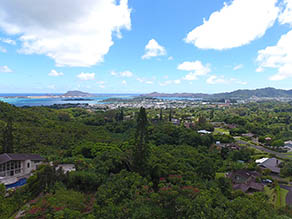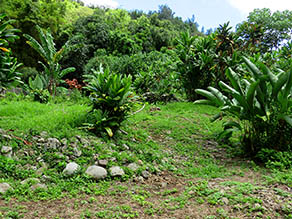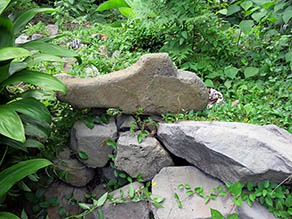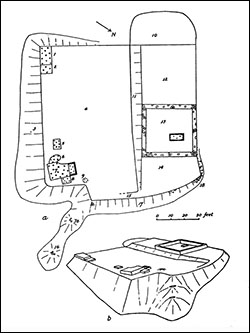 |
 |
 |
 |
||||||
|
|
|
|
|
|
|
|
|
|
|
|
|
|||||||||
 |

“The significant location of the heiau and the mo‘olelo associated with it comes from the goddess Hina. Hina is a multi-faceted deity, and her elements have to do with the ocean tides, the moon and its lunar rhythms, and the beating of kapa, another ‘ōiwi rhythmic movement of life. Her kinolau are the reefs or the papa, the laua‘e fern, limu kala, and coral. She is Hinakuluiua, the element of dropping rain. “Hina is the initiator of movement. The coral, the moon, and the sea are the essential elements of life and Hina in the form of the coral polyp, is distinguished as the first born in the Kumulipo. Kame‘eleihiwa describes Hinaōūholoko‘amoana as ‘Hina whose womb is filled with everything from the ocean.’ A makawalu of the term Leleahina provides some interesting correlations.
“None of the descriptions are tactile, with the exception of Hina’s kinolau [physical manifestations]. In the deconstruction of the term, Leleahina, it is my analysis that the heiau is a place in which to invoke, placate, or honor the element(s) of Hina in her function as the moon. Movement is pivotal, the bursting forth of rain, the color grey, not only as the color of the moon but also the nuances created by it on specific nights, i.e. the silvery gray beams that shoot through the forest, lighting it up in a silvery glow. "As the moon, Hina is the initiator of the ebbs of the ocean tides as it controls the rhythmic movement of the ocean, responsible for the growing of sustenance, medicines, and other such growth. Hina’s movements are life giving, hence, this bursting forth, this movement, of the tides, the rain, the wind, and the ocean, are the elemental signifiers of Hina In this element she is the cohort of Lono, as initiator of growth through the rhythmic or seasonal movements necessary for sustenance. “The coral polyp, the low lying reefs are the body of Hina in the element of the ocean. In this environment, she is the nesting place of life, in rhythm with Kanaloa, sparked by Kū, and mingling with Lono and Kāne. “The connection of Leleahina in the complex of sites located in the ‘Ili of ‘Ioleka’a have to do with the ‘ili’s function as a place of learning. The heiau that are located there, have much to do with the health and well-being of kānaka ‘ōiwi, and the training of those who would be kahuna and caretakers of kāhuna and would have to have a place to learn and live. I believe ‘Ioleka’a is such a place.”
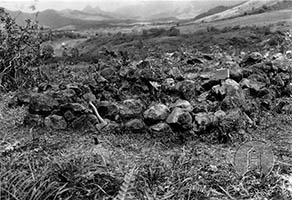
"Located nearly at the foot of the palis, the heiau covers an area of 110 feet by 115 feet. Two platforms were apparently the prominent features formerly, but now the higher division on the north has been disturbed and a small graveyard 40 feet square has been built on this platform. Here Keli‘ikanaka‘ole and his wife Kopaea are said to be buried. The stones for building the heavy wall which surrounds the graves were undoubtedly taken from structures which were on the mountain side of the present burials, for there are the partial foundations of many walls which have been so badly disturbed that it is impossible to determine their former position. On the lower platform, roughly 74 feet by 110 feet, are some interesting remains, particularly that of the probable lele or anu‘u tower, which is in the southeast corner. A growth of guava, fern and some lantana now covers the site." Leleahina heiau, southwest of He‘eia, Site 329: a. ground plan; b. perspective sketch:
|
 |
|||||||
 |
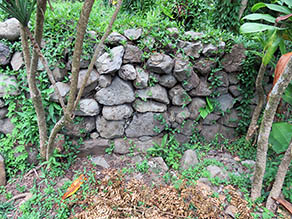
|
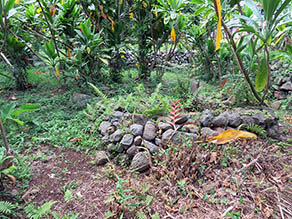
|
 |
||
 |
Separated from the rest of He‘eia is an ‘ili (strip of land) out on the Mōkapu Penninsula. Here a distinct lifestyle took place in old times. This is the ‘ili of Mōkapu.
|
 |
||
 |
|
 |
||

|
 |
||||
|
||||
Copyright 2019 Pacific Worlds & Associates • Usage Policy • Webmaster |
||||
